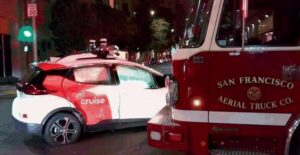
Cruise robotaxi crashes into firetruck in San Francisco
Two companies operate self driving taxis in San Francisco: Waymo and Cruise. Over 92 problems were reported in 2023, which led to Cruise being suspended, in part due to footage of a fatal accident they didn’t release to authorities.
Just a few of the problems that made the local paper:
Swan R (2023) Fog blamed for Waymo cars blocking traffic. San Francisco Chronicle. In addition to the five Waymo vehicles blocking traffic, on September 30 a Cruise taxi eased to a stop after nearly crashing into a Muni N-Judah train near Carl and Cole streets and obstructed the light-rail tracks in both directions for 7 minutes. Last week Cruise recalled the software on 300 vehicles after one rear-ended a Muni bus.
Cano R (2023) Self-driving cars are causing mayhem on S.F. streets, officials say. Will their expansion be restricted? San Francisco Chronicle. SF firefighters were battling a two-alarm apartment blaze at Hayes and Divisadero streets when a driverless Cruise car entered the active firefighting scene and nearly ran over fire hoses on the street. Firefighters stood in front of the car to try to get it to stop, but the autonomous vehicle came to a halt only after one of them smashed the Cruise car’s front window.
Cano R (2023) California DMV suspends Cruise’s driverless taxis in S.F. after company allegedly withheld car crash footage. SF Chronicle. The suspension comes weeks after a driverless Cruise taxi was involved in a crash resulting in severe injuries to a pedestrian crossing at Fifth and Market streets in downtown San Francisco.
In 2023, the city’s Municipal Transportation Agency and County Transportation Authority documented at least 92 incidents between late May and December where self-driving taxis created mayhem on city streets — disrupting traffic, Muni transit and emergency responders.
- September 22: A Cruise vehicle entered a bus lane, stopped next to a Muni bus near the intersection of O’Farrell and Franklin streets and blocked traffic for 21 minutes.
- September 23: Five Cruise autonomous vehicles blocked southbound Mission Street near 29th Street. One stopped on the central double yellow line, partially blocking an opposing lane of traffic for at least 13 minutes.
Unexpected and unplanned stops obstructing travel lanes create hazards. They can cause other vehicles to make dangerous abrupt lane changes, brake or accelerate rapidly, or veer into bike lanes or crosswalks. They can cause rear end collisions.
Of the 92 unique incidents reported to the City between May 29, and December 31, 2022:
- 88% occurred on streets on which Muni buses, light rail vehicles, and
streetcars provide transit service; - 19% occurred in intersections
- 60% occurred on the San Francisco bike network, and
- 70 % occurred on the City’s High Injury Network—the 12% of San Francisco
streets that account for more than 68% of severe or fatal injury crashes.
AUTOMATED VEHICLES INTERFERE WITH MASS TRANSIT
Public transit is the most efficient motorized form of transportation. Multiple generations of federal, state and local taxpayers and transit riders have dedicated funding to build, expand and maintain the seventh largest public transit system in the nation, essential to the economic vitality of the City, the city’s climate action and air quality goals, and equity goals. With one of the cleanest public transit fleets in the nation, Muni plays an especially critical role in offering freedom of movement to people who do not own cars while making very minimal contributions to the air quality problems that undermine human health. Muni’s rail and bus operations, which serve hundreds of thousands of users every day, operate mostly in a mixed road environment in which they must compete with other motor vehicles for space. This mixed traffic poses continuous challenges to reliable transit operations, and survey responses show that reliability is the characteristic that most affects travelers’ use of transit.
Automatic vehicles delay mass transit, leading to rider dissatisfaction for not only those affected but those waiting for a bus to arrive.
One of the big problems with self-driving vehicles is that any new construction or changes need to be updated in the system, or an automated car has to stop since it doesn’t know how to proceed. Cruise and Waymo cars are constantly updating the map, and when befuddled there is 24 x 7 coverage by employees who can remotely, or worst case quickly show up to fix the problem. Fairly easy to do a tiny 49-square mile city (Houston is 665 sq mi). But larger cities and rural areas will not be mapped often enough to prevent car-stopping confusion. If self-driving taxis can’t be made to work in San Francisco, it is hard to imagine them operating anywhere else successfully.
Mass transit is a far better way to use energy efficiently as well.
Alice Friedemann www.energyskeptic.com Author of Life After Fossil Fuels: A Reality Check on Alternative Energy; When Trucks Stop Running: Energy and the Future of Transportation”, Barriers to Making Algal Biofuels, & “Crunch! Whole Grain Artisan Chips and Crackers”. Women in ecology Podcasts: WGBH, Financial Sense, Jore, Planet: Critical, Crazy Town, Collapse Chronicles, Derrick Jensen, Practical Prepping, Kunstler 253 &278, Peak Prosperity, Index of best energyskeptic posts
